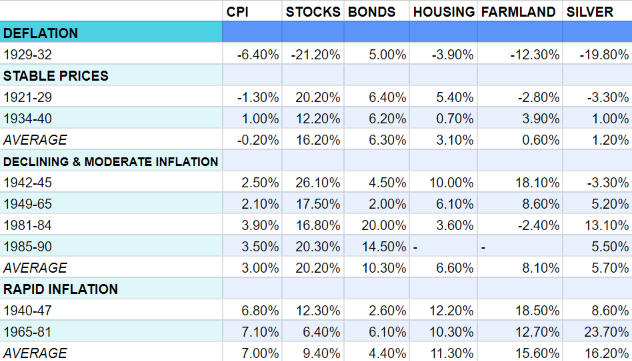Over the long haul, inflation is the prime mover of investment markets.
When inflation is falling, financial assets like stocks and bonds thrive.
Therefore, when inflation is rising, historically speaking, hard assets like gold, oil and real estate take over.
From the early 89’s to mid 90’s, inflation was low and well-behaved. As a result, stocks and bonds gained ground.
What does that mean for today’s investor?
Well, it means that during times of rising inflation (such as we are experiencing now) buying and holding a basket of stocks, bonds and diversified mutual funds could be a formula for potential financial loss.
It’s indisputable that stocks and bonds have made money over the very long term. Unfortunately, there have been plenty of uncomfortably long periods when it has actually paid to be on the sidelines.
Those who bought at the top of the market in 1929 (for example) took nearly 20 years to make back what they lost during the great Stock Market Crash. Although not nearly as dramatic or catastrophic, the early 1990’s served to be a similar scenario.
During the 1980’s to early 1990’s, central banks focused on fighting inflation. Wall Street prospered under low inflation and stable economic growth.
In sharp contrast, we find the current economic climate showing a semblance to the 1970’s… Which was a decade of rapid inflation and uneven growth. This boded disastrous for stocks and bonds.
Inflation ahead means the latter 2020’s could very well follow the same historical pattern of the 1970’s. After all, history does have a tendency to repeat itself.
What will be the investments of choice in the years ahead?
To explain the best possible roadmap ahead, we created a historical graph called “Annual Rates of Return” based on data gathered from 1929 to the early 1990’s.
The detailed graph shows how various investments have historically performed at different levels of inflation. Incidentally, the data speaks volumes on the cyclical nature of the stock market and how inflation throws both caveats and windfalls into the mix.
As the graph highlights, times were markedly worse during the 1966 - 1974 period. That near decade stretch shows that most stocks did not even generate positive nominal returns.
Moreover, there was also a big price to pay for not making any moves at all. The gut-wrenching volatility of the period, including the historic sell-off of 1973 - 1974, many large blue-chip stocks lost more than half of their value in a devastating decline.
Bonds were certainly no picnic either. Similar to Fed rates today, top-quality bond yields rose from the 4 to 5% range during the mid-1960’s.
Fast forward, interest rates skyrocketed to an alarming 15% in the early 1980’s under (then Fed chair) Volker. Bondholders who hung on until their bonds matured received their full principal but suffered an enormous loss of purchasing power.
Clearly the road to riches, in a world of rapidly rising inflation, does not run through financial assets such as stocks and bonds.
Investment Roadmap for the Next Decade
Poor returns for stocks as a group doesn’t mean that every stock will flop. Nor does it suggest losses for every fixed-income investment. We’re convinced that if you do your research, you will be able to find companies that have the potential to score gains in an otherwise desultory financial environment.
Let us also be clear; not every real or ‘hard’ asset will be a guaranteed winner over the long-term either. There will be plenty of ways to lose money in bad real estate, gold or energy stocks for that matter.
The economic times ahead will be a time of staggering opportunities for those who know how to recognize them. Higher inflation does not necessarily mean economic catastrophe. In fact, it could prove to be quite the opposite. Although now more than ever, timing will become far more essential to success. Hard assets like real estate and gold may very well trade places with financial assets as the portfolio picks of choice because they are a store of wealth during market volatility. Regardless, this will be an age of opportunity but the opportunities will be considerably different, as we are amidst unprecedented times.
Wrap Up
Ultimately, every investor must weigh the pros and cons before making any investment decisions. This article has presented empirical, historical data revealing which investment sectors have performed well during times of inflation. We suggest that every investor take both history and current economic conditions into consideration, while executing due diligence in regard to their investment portfolio.
We hope this article was both educational and insightful. Sharing is caring. Please, feel free to share this article with a friend or fellow investor!
Get In Touch
Our investment professionals understand that building a wealth management strategy can be a bit overwhelming. Take your first steps toward financial freedom by scheduling a no-obligation, investment consultation with a registered Investment Adviser Representative.
https://www.leeb.net/customer-service-leeb-capital-management/







